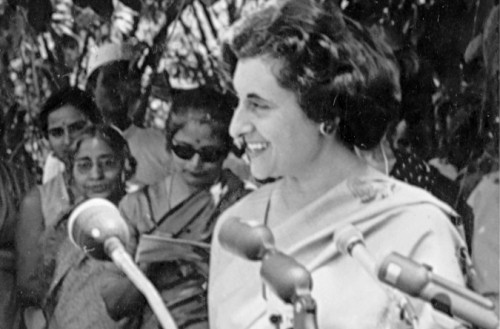Image: Indira Gandhi.
Today marks the fortieth anniversary of Indira Gandhi’s declaration of a national emergency in India, which led to an 18-month period of autocracy. Civil rights were suspended, political opponents and journalists were arrested without the right to trial, censorship was imposed, elections were cancelled, non-Congress state governments were dismissed, the constitution changed.
Those who care to recall that it ever happened describe The Emergency, as it came to be known, as “the darkest period of independent India”. This is certainly how it is presented in Salman Rushdie’s Midnight’s Children and Rohinton Mistry’s A Fine Balance. Yet it has received surprisingly little attention in the political science and development literature. In fact, much of the existing literature incorrectly assumes that India has experienced uninterrupted democracy since 1947.
But if we care to look a little closer, I think India’s Emergency can tell us something very important about how change happens. In a new DLP paper out next month, I look at this period of autocracy, and the need to consider the relationship between structure and agency to understand the institutional change that took place.
The generally accepted version of events is that democracy triumphed; unable to resist the opposition of various groups who had been empowered by a quarter of a century of post-Independence democracy, Gandhi abandoned her ambitions of dictatorship within two years.
Democratic structure overcame Gandhi’s agency. That’s the line that fits most neatly into the dominant institutional analyses. Even political approaches tend to prefer it this way, and the widespread assumption is that people’s actions are the result of the political structures they inhabit.
I’m not convinced. I argue that we ignore the interplay between structure and agency, between actors and the environment they find themselves in, at our peril. India’s shift to autocracy and its return to democracy can tell us much about the fragility of political institutions and democracy, and – crucially – how change happens. How one person, or a very small group of people, can both wipe away an institutional structure and, in a moment, restore it again. The importance of agency.
Several factors contributed to Prime Minister Gandhi’s decision to declare a national emergency in June 1975. A student-based protest movement, stirred by worsening economic problems, had organised a series of debilitating strikes in the country. Gandhi was found guilty of a minor electoral malpractice offense (she had hired a government official to work on her previous election campaign team – trivial, but still illegal). When the Supreme Court upheld the guilty verdict, her government imprisoned political opponents and imposed a media blackout.
Over the next 18 months, to concentrate power into the hands of the executive, appointments were made purely on the basis of personal loyalty. Perhaps the most notorious government excesses were the slum clearances and family control programs. Poor Indians were forcibly removed from their homes and many were made to undergo sterilisation.
Then, as suddenly as the Emergency had begun, it ended. In January 1977, Gandhi announced an election. In March she was comprehensively defeated in the polls and democracy was restored.
A structuralist approach cannot reconcile the authoritarian Indira Gandhi with her unexpected decision to hold elections and return to democracy. To explain this, it is necessary to consider people’s capacity to feel ambivalent about their own actions, to reflect on decisions they have made, and to change their minds.
A closer examination of the evidence shows that the public was only able to vote Indira Gandhi out of office because she decided to hold elections. She was under little pressure from inside India itself to hold elections and her announcement took most observers completely by surprise.
She had for some years exploited the structural weaknesses of India’s less-than-robust democracy and so was confident that she would face little opposition when she imposed autocratic rule – and she was right. Many actively supported her, and all the evidence suggests that she could have carried on. It seems the only reason she didn’t was because she decided not to. She had a genuine desire to see the country return to democracy, inspired at least partly by criticism of her actions by some of her close friends.
So while some dismiss agency as “an academic affectation that does not help development in practice”, I’d say we need to take a much closer look at the relationship between structure and agency. We need to look at how it shapes people’s behaviour as well as political outcomes. This argument has been made by David Hudson and DLP’s late founding director Adrian Leftwich in their influential paper on political analysis.
They suggest that donors’ engagement with the politics of development is based on a narrow conceptualisation of agency, and this is certainly my experience of the various political economy analysis meetings I’ve been involved in. It is common to hear development researchers and practitioners talk in simplistic terms about identifying elites and their incentives. The prevailing view seems to be that everyone works to further their own fixed narrow self-interest – except for development practitioners themselves, of course, who work selflessly in the interests of humanity.
I think the first lesson of India’s Emergency is that we cannot interpret an individual’s incentives only with reference to their position in a political system. In other words, if an individual is a member of the local political elite, we should not assume that their only incentive is keeping hold of or extending their power. This may be true, but we might also consider the possibility that they have a deep commitment to improving the lives of their community. Careful political analysis should uncover this.
A second lesson is the possibility that someone with much political agency at their command might simply change their mind. This puts the tool of persuasion back into the toolkit of all who hope to bring about change by ‘thinking and working politically’. We should not assume that an individual’s position is fixed. The merits of the case might move them.
And part of the art of persuasion is putting conscious effort into to how we frame our message. We need to think about how we put our case, how we can change the narrative, and who we can bring into the argument.
Current political thinking in development is still dominated by a rather narrow focus on incentives. India’s Emergency suggests that this is only scratching the surface of the many factors that contribute to change.










